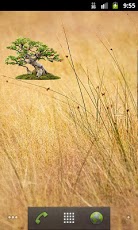Bonsai tree Widget 1.1
Free Version
Publisher Description
Bonsai (盆栽?, lit. plantings in tray, from bon, a tray or low-sided pot and sai, a planting or plantings, pronunciation (help·info))[1] is a Japanese art form using miniature trees grown in containers. Similar practices exist in other cultures, including the Chinese tradition of penjing from which the art originated, and the miniature living landscapes of Vietnamese hòn non bộ. The Japanese tradition dates back over a thousand years, and has its own aesthetics and terminology."Bonsai" is a Japanese pronunciation of the earlier Chinese term penzai. A "bon" is a tray-like pot typically used in bonsai culture.[2] The word bonsai is often used in English as an umbrella term for all miniature trees in containers or pots. This article focuses on bonsai as defined in the Japanese tradition.The purposes of bonsai are primarily contemplation (for the viewer) and the pleasant exercise of effort and ingenuity (for the grower).[3] By contrast with other plant cultivation practices, bonsai is not intended for production of food, for medicine, or for creating yard-size or park-size gardens or landscapes. Instead, bonsai practice focuses on long-term cultivation and shaping of one or more small trees growing in a container.A bonsai is created beginning with a specimen of source material. This may be a cutting, seedling, or small tree of a species suitable for bonsai development. Bonsai can be created from nearly any perennial woody-stemmed tree or shrub species[4] that produces true branches and can be cultivated to remain small through pot confinement with crown and root pruning. Some species are popular as bonsai material because they have characteristics, such as small leaves or needles, that make them appropriate for the compact visual scope of bonsai.The source specimen is shaped to be relatively small and to meet the aesthetic standards of bonsai. When the candidate bonsai nears its planned final size it is planted in a display pot, usually one designed for bonsai display in one of a few accepted shapes and proportions. From that point forward, its growth is restricted by the pot environment. Throughout the year, the bonsai is shaped to limit growth, redistribute foliar vigor to areas requiring further development, and meet the artist's detailed design.The practice of bonsai is sometimes confused with dwarfing, but dwarfing generally refers to research, discovery, or creation of plant cultivars that are permanent, genetic miniatures of existing species. Bonsai does not require genetically dwarfed trees, but rather depends on growing small trees from regular stock and seeds. Bonsai uses cultivation techniques like pruning, root reduction, potting, defoliation, and grafting to produce small trees that mimic the shape and style of mature, full-size trees.In 1910, shaping with wire was described in the Sanyu-en Bonsai-Dan (History of Bonsai in the Sanyu nursery). Zinc-galvanized steel wire was initially used. Expensive copper wire was only used for trees that had real potential.[55][56] Between 1911 and about 1940, mass-produced containers were exported from Yixing, China, and made to the specifications of Japanese dealers. These were called Shinto (new crossing or arrival) or Shin-watare. These were made for increasing numbers of enthusiasts. Some containers, including primitive style ones, were also being made in Formosa.[46][57]By 1914, "at the N.E. corner of Shiba Park is a permanent bazaar (the first of its kind established in Tokyo) where hosts of native-made gimcracks can be bought at fixed prices. The exhibits of potted plants and dwarf trees held here from time to time attract lovers of such things."
About Bonsai tree Widget
Bonsai tree Widget is a free app for Android published in the Other list of apps, part of Home & Hobby.
The company that develops Bonsai tree Widget is BAMBULKA Developer. The latest version released by its developer is 1.1. This app was rated by 1 users of our site and has an average rating of 4.0.
To install Bonsai tree Widget on your Android device, just click the green Continue To App button above to start the installation process. The app is listed on our website since 2013-02-17 and was downloaded 12 times. We have already checked if the download link is safe, however for your own protection we recommend that you scan the downloaded app with your antivirus. Your antivirus may detect the Bonsai tree Widget as malware as malware if the download link to com.olia.widget.Bonsay is broken.
How to install Bonsai tree Widget on your Android device:
- Click on the Continue To App button on our website. This will redirect you to Google Play.
- Once the Bonsai tree Widget is shown in the Google Play listing of your Android device, you can start its download and installation. Tap on the Install button located below the search bar and to the right of the app icon.
- A pop-up window with the permissions required by Bonsai tree Widget will be shown. Click on Accept to continue the process.
- Bonsai tree Widget will be downloaded onto your device, displaying a progress. Once the download completes, the installation will start and you'll get a notification after the installation is finished.
